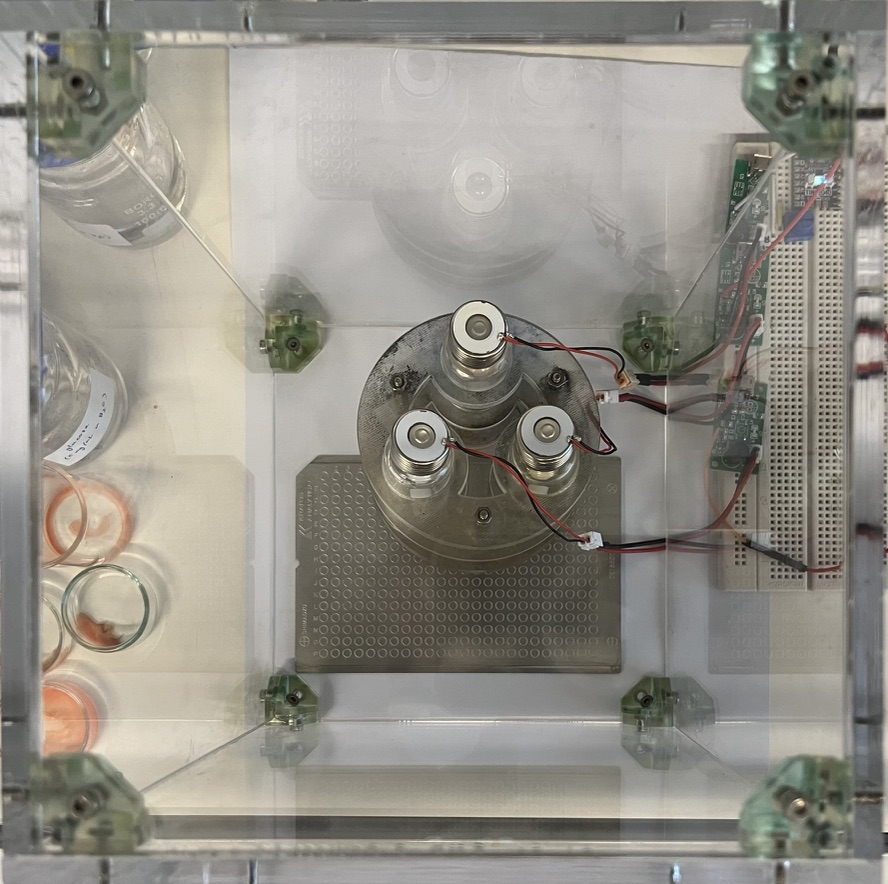Hello! My name is Jakub Wosik and I’m a BSc Chemistry (Hons) student just finishing up my fourth year here at the University of Glasgow.
Last summer I was faced with the decision of what subfield of Chemistry my final year project was going to revolve around. Following a six-week summer internship in the Complex Chemistry labs of the University’s Advanced Research Centre (ARC), I was particularly keen about the possibility of tackling areas that deviated a bit more from our base curriculum or areas that one may initially associate with the field of Chemistry. I was eager to witness and understand more about the ever-evolving incorporation of automation and digitisation into the field, and learn some new, relevant skills along the way. As such, I selected “Complex Chemistry” as my top preference for my Honours project and was fortunate enough to join Dr. Hessam Mehr’s research group as a result.

Brief project background
My seven weeks in the Mehr Group revolved around the exploration of aerosol microdroplets as a reaction medium for chemical synthesis. The idea behind this stems in part from the successful applications of other departures from traditional “flask-based” synthetic approaches, such as flow chemistry and microfluidics, with their own sets of advantages. The two main incentives for performing chemistry in the aerosol medium, i.e. in “spray” form are:
- The potential of different chemical pathways/reactivity as a result of substantially confined volumes — reaction acceleration in microdroplets has been a prominent observation in literature.
- Performing chemistry within this medium is inherently “stochastic”. Is there potential for novel pathways for a given set of chemical building blocks based on the probabilistic nature of droplet interactions within an aerosol cloud?
My experience
More specifically, my experience in the lab was very much focused on demonstrating the feasibility of some known organic reactions via an ultrasonic atomiser-based apparatus for droplet generation. The “reactor” (photographed below) was connected to a computer via a MicroPython circuit, and any chosen reaction was controlled and tuned via a Python program. One thing I very much appreciated and enjoyed was getting to assemble a physical circuit from scratch, coupling it with a script and seeing it all come to life when testing out the spraying of a solvent of choice. Hessam was very helpful and keen to demonstrate processes such as soldering and laser-cutting (for the assembly of the acrylic box, as seen in the photograph), as well as explaining the unfamiliar features of the algorithm and circuitry.

The biggest challenge within the project certainly had to do with my choice to explore organic reactivity in the medium, coupled with our primary method of droplet detection — microscopy. The droplets generated during a given aerosol reaction were allowed to settle onto a glass slide for visualisation under a Raspberry Pi-based RGB microscope. A reaction is deemed to have proceeded if distinct reagent and product droplets can be identified. This distinction is typically attributed to a significant difference in colour between the two — something that organic chemistry is not particularly known for. As such, my resilience was certainly tested when scouring the lands for an organic reaction that would undergo a distinct colour change in a reasonable timeframe under mild conditions. What this meant was that the eventual sight of a beautiful contrast between distinct red/orange and colourless droplets following an ado-dye synthesis in the aerosol medium put a big smile of excitement and relief on my face.

Nearing the end of my project, with the help of Dr. Mehr’s programming expertise, I had the opportunity to witness the seemingly simple, yet promising potential of changing up the algorithm loop to facilitate multi-step reactivity involving an unstable intermediate, i.e. stoichiometric spraying in a sequential manner, as opposed to the simultaneous spraying of two atomisers as per a simple binary reaction. Starting to see the extent of how such an affordable apparatus could be tailored and fine-tuned through the power of code to facilitate a truly hands-off approach to performing mainstream chemistry in an atypical medium was, needless to say, a very rewarding way to wrap up my project.
Final thoughts; what next?
It is an understatement to say that I am incredibly grateful to Dr. Hessam Mehr for all the patience and guidance throughout my time here. The group provided me with a refreshing look at a different side of Chemistry that aims to take full advantage of where the world is heading technologically — and it’s doing so with accessibility and ease-of-communication in mind. While my time in the group is now over, with the prospect of exploring various other yet-unclear endeavours, the experience I have gained working in Mehr Research is nothing short of invaluable, and the skills I’ve developed will undoubtedly aid me in any facet of Chemistry, or many other potential career path for that matter.
At the time of writing this post I’m preparing for my final degree exams coming up in just under three weeks, so fingers crossed! What keeps me going are some great destress socials with friends; playing some great games and talking for hours about Japanese animation and graphic novels! Following graduation I hope to take some time to enjoy some lovely (hopefully!) sun with my family in Poland, as well as take my partner around some places she’s not seen there yet!
That’s all, folks!

Leave a Reply
You must be logged in to post a comment.